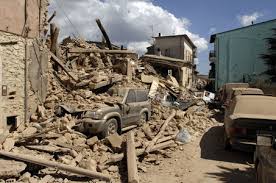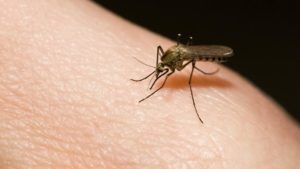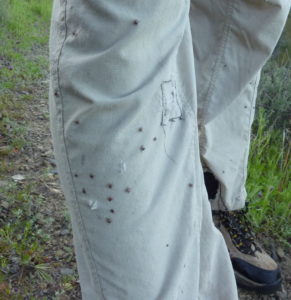In an emergency situation, like an earthquake, hurricane or nuclear attack, insect control in the following days and weeks will be a problem.
Controlling insects is probably not the most important concern that comes to your mind.
 Obviously, survivors will need to think about water, food, shelter and, in the case of a nuclear attack, protection from radioactive fallout.
Obviously, survivors will need to think about water, food, shelter and, in the case of a nuclear attack, protection from radioactive fallout.
All these would be critical needs to address.
In addition to these major concerns, though, you need to ensure you can protect yourself from insects that will be opportunistic and multiply rapidly especially in the first few days after a catastrophe that hits a major city.
Flies of all sorts will be a problem as well as roaches and parasites such as lice and ticks. Depending on the climate and time of year, disease-carrying mosquitoes may be present in large numbers.
In a catastrophe that causes widespread damage to buildings and necessitates large numbers of people to escape to makeshift shelters the normal means of protection we have from insects will be lost.
This is why it is definitely a good idea to keep a supply of effective yet safe insect repellents and insecticides in your emergency kit.
 For personal use, the best-known repellent against mosquitoes, biting flies and ticks is DEET. DEET has been shown to be safe for use on skin and is effective. It can damage some polymeric materials, however, so it shouldn’t generally be applied directly to fabrics.
For personal use, the best-known repellent against mosquitoes, biting flies and ticks is DEET. DEET has been shown to be safe for use on skin and is effective. It can damage some polymeric materials, however, so it shouldn’t generally be applied directly to fabrics.
On clothing and gear, a good repellent and insecticide for crawling insects as well as mosquitoes are permethrin. It is not effective if used directly on skin since it is rapidly deactivated when used in this way. Permethrin solution may be applied to clothing, tents, mosquito nets and fabric gear and allowed to dry. Used in this way, it acts as an effective repellent and insecticide that lasts up to six weeks.
Permethrin solution that is to be sprayed directly on clothing should be diluted to 0.5%. Any spraying should be done outside and spray should not be permitted to be blown onto surrounding people or animals. The solution should not be allowed to contact your skin.
 A better method than spraying is to soak clothing or fabric gear with permethrin solution in a closed plastic bag. For example, a 24 oz (750ml) solution of permethrin in water at a concentration of 0.15% can be placed in a plastic bag to treat a pair of pants, a shirt, and socks for one person. Let the bundle of clothes soak up all the solution over a period of two hours in the closed bag. After the clothing is removed from the bag and allowed to dry thoroughly outside it can be safely worn. Protection lasts up to six weeks even with weekly washing. Clothing is not damaged in any way by the permethrin solution.
A better method than spraying is to soak clothing or fabric gear with permethrin solution in a closed plastic bag. For example, a 24 oz (750ml) solution of permethrin in water at a concentration of 0.15% can be placed in a plastic bag to treat a pair of pants, a shirt, and socks for one person. Let the bundle of clothes soak up all the solution over a period of two hours in the closed bag. After the clothing is removed from the bag and allowed to dry thoroughly outside it can be safely worn. Protection lasts up to six weeks even with weekly washing. Clothing is not damaged in any way by the permethrin solution.
An interesting fact is that permethrin treatment of clothing method is used by the military to provide protection to personnel when they are in areas where insects are a problem. One important caveat is not to dispose of waste permethrin solution in water supplies since it is very toxic to aquatic life. It has no ill effects on most mammals including humans and dogs. Cats, however, have a sensitivity to it and it and they should not be exposed to permethrin spray or treated clothing.
- Permethrin is non-toxic to humans.
- When applied to clothing, the chemical will effectively repel insects such as ticks, mosquitoes and black flies for up to six weeks even with weekly laundering.
- The effectiveness of permethrin-treated clothing has been proven and is currently used for military uniforms in Afghanistan.
- It is an especially good deterrent against ticks as the ticks will fall off and die when they crawl over even ten inches of treated fabric. It is a good idea to wear permethrin-treated pants while walking in tick-infested grasslands.
- In mosquito and black fly infested areas, clothing and packs treated with permethrin can serve as an effective repellent. Permethrin is better suited for application to fabric than is DEET.
- Permethrin used for clothing treatment is a good complement to DEET-based repellents used on skin. (Permethrin, although not harmful to skin, should never be used on skin since it will rapidly become ineffective as a result of reaction with skin oils.)
Handling large fly populations in an emergency situation may also be a problem. Flies will multiply rapidly if there are decaying human corpses left exposed or under rubble resulting from an earthquake or explosion. Human excrement will also be in the area where survivors congregate in the first few days. Flies will be strongly attracted to the excrement and lay their eggs in it.
Obviously, it is best to try to bury that which will play a role in increasing fly populations. In addition to this, it would be prudent to have on hand a small quantity of fly bait killer that is available at farm supply shops. A small quantity placed near areas where human excrement is collected can eliminate a large number of flies.

